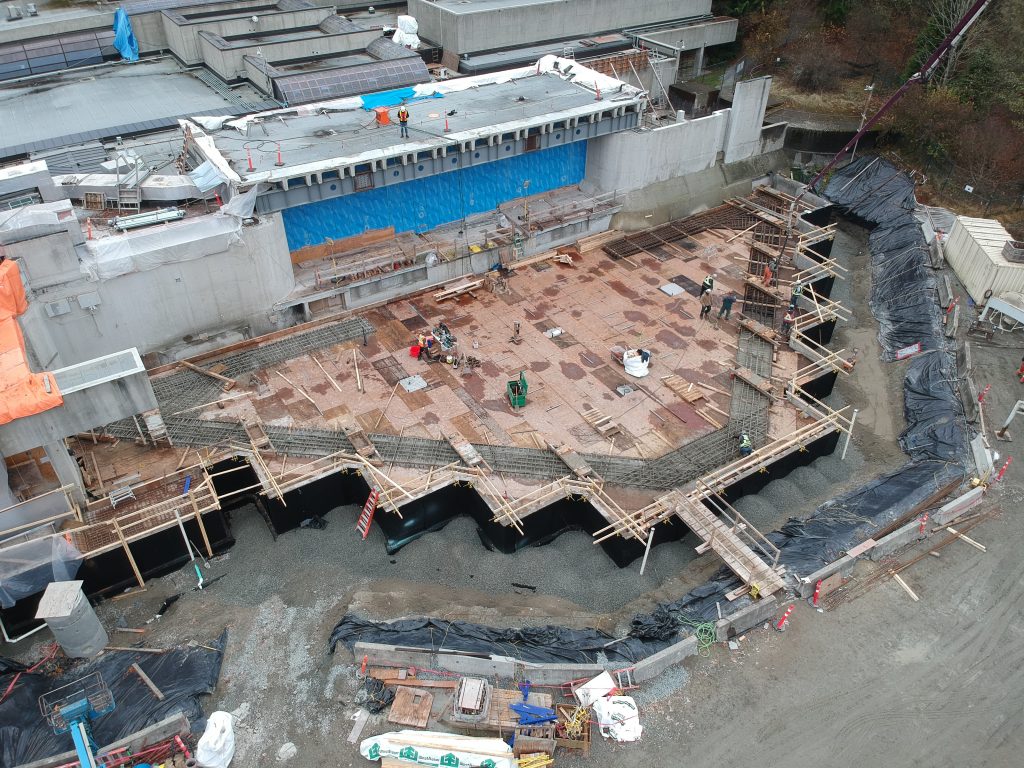
Words by Aylin Turker, Digital Content Creator, Sustainability Hub.
The Great Hall of the Museum of Anthropology at UBC (MOA) is a cultural and architectural masterpiece that requires modern seismic safety measures to protect against future risks.
 In this interview, Dr. Tony Yang, a professor in the Department of Civil Engineering and an expert in earthquake engineering, discusses the implementation of base isolation technology to upgrade the Great Hall's seismic safety without compromising its historical significance.
In this interview, Dr. Tony Yang, a professor in the Department of Civil Engineering and an expert in earthquake engineering, discusses the implementation of base isolation technology to upgrade the Great Hall's seismic safety without compromising its historical significance.
Diving into how the design and execution prioritized sustainability, and the importance of seismic safety in tectonically active regions such as Vancouver, Yang shares advice for engineers and architects working on projects involving historic or culturally significant structures. He also discusses educational opportunities at UBC related to seismic safety and the significance of protecting culturally meaningful buildings for cities across the Pacific Northwest.
Can you tell me about the specific seismic update measures that were implemented in the Great Hall of MOA?
 The Great Hall of MOA is being seismically upgraded with base isolation technology. This is a technology where we isolate the building from the earthquake, by cutting all the foundations and putting the building co to co on the roller so when the grounds move, the building doesn't experience the earthquake feeling. That's the technology that is currently in the process of being implemented to protect the artifacts in the building.
The Great Hall of MOA is being seismically upgraded with base isolation technology. This is a technology where we isolate the building from the earthquake, by cutting all the foundations and putting the building co to co on the roller so when the grounds move, the building doesn't experience the earthquake feeling. That's the technology that is currently in the process of being implemented to protect the artifacts in the building.
How did you balance the need for seismic safety with the preservation of the building's cultural and architectural heritage?
We balance it 100%. Nothing you see in the building is being touched - we only protect it. As we do the engineering below the ground, everything remains absolutely the same.
How did you collaborate with other stakeholders such as MOA staff and the wider community in planning and executing the seismic upgrades?
We had a meeting very early on during the process where key staff from MOA and the other key stakeholders within the university gathered. And the best way for us to execute this project is of course by listening to their needs. As MOA is the most influential building on the UBC campus, designed by Arthur Erickson - a well-known Canadian architect, UBC wants to preserve it. Thus, they were very clear on maintaining 100% of the way the building looks inside and outside. Working really hard on not showing any traces of the upgrade but still being able to protect the building, we choose the base isolation technology. That means, we actually lifted the building. Then, hopefully, during the event of an earthquake, we can separate what we call the isolated earthquake shaking from the ground to the structure and protect everything above.
How can other historic or culturally significant buildings be updated to meet modern seismic safety standards while preserving their unique features and significance?
Base isolation is one way that it's commonly used to protect historical buildings, where very minimum intrusion to the building is necessary, as you do everything on the foundation level. So you can try to preserve it - to a limit - because even if you put everything on the roller if the superstructure is frail it will still be damaged. So we have to cleverly strengthen the superstructure and a lot of times we hide it in an area that people don't see, to make sure it can still be protected.
Can you talk about any innovative or unique engineering solutions that were developed specifically for the Great Hall seismic updates?
Base isolation technology is an innovative technology where you actually protect the building by isolating the earthquake shaking from the building. Typically when people do seismic upgrades,  it's because buildings are too weak for taking the load from earthquakes naturally or most of the seismic upgrade is to strengthen the building with the stronger capacity to take the load. And that usually is done by adding a wall or a brace somewhere so the building can take more load or take larger loads. Base isolation is completely different as it involves cutting all the foundations. Instead of strengthening the building, we weaken the building in a way. When a building is weakened, the stiffness of the building reduces. During earthquakes, the inertia force is mass times acceleration. Stiff buildings will have a high acceleration, which will attract more earthquake forces. On the other hand, seismically isolated buildings are softer, which will reduce the earthquake force experienced by the building.
it's because buildings are too weak for taking the load from earthquakes naturally or most of the seismic upgrade is to strengthen the building with the stronger capacity to take the load. And that usually is done by adding a wall or a brace somewhere so the building can take more load or take larger loads. Base isolation is completely different as it involves cutting all the foundations. Instead of strengthening the building, we weaken the building in a way. When a building is weakened, the stiffness of the building reduces. During earthquakes, the inertia force is mass times acceleration. Stiff buildings will have a high acceleration, which will attract more earthquake forces. On the other hand, seismically isolated buildings are softer, which will reduce the earthquake force experienced by the building.
How did sustainability factor into the design and execution of these updates?
The whole reason for the seismic upgrades is sustainability. We want to ensure when the next big earthquake comes, this building remains. If you don't, we will lose it, and that is very unsustainable.
How important is it to prioritize seismic safety in buildings, especially in regions with high seismic activities such as Vancouver and other cities in the Pacific Northwest?
We want to make sure the buildings will withstand a big earthquake. If you look at the news, Turkey is seeing a big loss in terms of population, and infrastructure. Previously in New Zealand, during the Christchurch Earthquake in 2011, the whole city was wiped out. Japan also experienced the same thing. We are in a similar seismic zone as everyone else. For example, where we are in Vancouver, if you go down south, we have California. If you keep on going down south you have Mexico and Chile and turn around the corner you have New Zealand, Indonesia, Taiwan, Japan, and Alaska. This is called the Pacific Ring of Fire. This is the most seismically active region in the world. So, making sure our [building] inventory here in Vancouver is protected must be our highest priority. We are not allowed to lose the entire city within a few minutes, and we're developing better solutions for it.
What advice would you give to other engineers or architects who are working on projects involving historic or culturally significant structures?
I think it's super important, particularly for culturally sensitive buildings because it takes centuries for them to accumulate. So it's equally important for engineers to really understand the building, and then try to preserve as much as we can.
Can you tell me about any courses or educational opportunities that you offer related to the Great Hall seismic upgrades? Or the broader topic of seismic safety and history or culturally significant buildings? What kind of topics or skills do these courses cover? And what do you hope students will take away from them?
 At UBC in the Department of Engineering, we offer a spectrum of courses. As we are the center for earthquake engineering in the country, we have both undergraduate courses and graduate courses regarding earthquake engineering and seismic design. In particular, the technology which is used for the Great Hall is taught in CIVL 505, Principles of Earthquake Engineering and Seismic Design, where we teach students the theory and ways to design the technology to protect buildings. However, there’s no one solution that fits all. So we train the student to understand the basic theory, the building code, and the novel technology that has already been developed. And then we can take the knowledge to apply. There are many projects in addition to the MOA seismic update here in town. The First Nation elderly center in Tsawwassen uses another technology with a self-centering friction damper.
At UBC in the Department of Engineering, we offer a spectrum of courses. As we are the center for earthquake engineering in the country, we have both undergraduate courses and graduate courses regarding earthquake engineering and seismic design. In particular, the technology which is used for the Great Hall is taught in CIVL 505, Principles of Earthquake Engineering and Seismic Design, where we teach students the theory and ways to design the technology to protect buildings. However, there’s no one solution that fits all. So we train the student to understand the basic theory, the building code, and the novel technology that has already been developed. And then we can take the knowledge to apply. There are many projects in addition to the MOA seismic update here in town. The First Nation elderly center in Tsawwassen uses another technology with a self-centering friction damper.